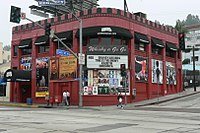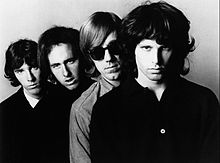We are called Rita's Rare Finds because all the albums and collectibles we list are hard to find in the condition we have them. I am probably one of the only sellers who has the original release of this iconic music from The Doors that pretty much changed my life and started the sixties era of new and different music in near mint condition. I'm sure you can find lots of the same record in good or very good condition or reissues from the year 2,000 and something, but not in near mint. We are unusual because I made it a point with my collection to only let me be the one to play my records being very careful, holding them by the edges and not messing them up in the process of recording them so I wouldn't have to keep playing the record if I wanted to listen to it again. This was how I kept my collection in the excellent condition my albums are in. Some online record sellers show albums that look great but they were actually professionally cleaned. I do have some good records I got second hand in my collection but I will always price them lower and inform the buyer of the way I got the album. |
The Doors is the debut studio album by American rock band the Doors, released on January 4, 1967, by Elektra Records. It was recorded in August 1966 at Sunset Sound Recorders, Hollywood, California, under the production of Paul A. Rothchild. The album features the extended version of the band's breakthrough single "Light My Fire" and the lengthy closer "The End" with its Oedipal spoken word section.[4] Various publications, including BBC and Rolling Stone, have ranked The Doors as one of the greatest debut albums of all time.[5][6]
The Doors worked on the material of their debut album throughout 1966 at various locations and stages, such as the Whisky a Go Go. The album's recording started after their dismissal from the venue, under the maintenance of Elektra Records. The recording of The Doors established the band's wide range of musical influences, such as jazz, classical, blues, pop, R&B and rock music.[7] It has been largely viewed as an essential part of the psychedelic rock evolution, while also being acknowledged as a source of inspiration to numerous other works.
The Doors and "Light My Fire" have been inducted into the Grammy Hall of Fame. In 2015, the Library of Congress selected The Doors for inclusion in the National Recording Registry for being "culturally, historically, or aesthetically significant".[8] The Doors has sold over 13 million copies worldwide as of 2015,[9] making it the band's best-selling album.[10] In 2003 and 2012, Rolling Stone ranked it number 42 on its list of the "500 Greatest Albums of All Time", repositioning it to number 86 in the 2020 edition.
Background[edit]

The Doors' final lineup was formed in mid-1965 after keyboardist Ray Manzarek's two brothers Rick and Jim 'Manczarek' left Rick & the Ravens, whose members included besides Manzarek, jazz-influenced drummer John Densmore and then-novice vocalist Jim Morrison. The group was integrated when guitarist Robby Krieger agreed to join.[12] Though he had previous experience playing folk and flamenco, Krieger had only been playing the electric guitar for a few months when he was invited to become a member of the band, soon renamed the Doors.[13] They were initially signed to Columbia Records under a six-month contract, but they asked for an early release after the record company failed to secure a producer for the album and placed them on a drop list.[14]
Following their release from the label, the Doors played residencies in mid-1966 at two historic Sunset Strip club venues, the London Fog and Whisky a Go Go.[15] They were spotted at the Whisky a Go Go by Elektra Records president Jac Holzman, who was present at the suggestion of Love singer Arthur Lee.[16] After he saw two sets, Holzman called producer Paul A. Rothchild to see the group.[17] On August 18, after attending several appearances of the band, Holzman and Rothchild ultimately signed them to Elektra Records.[18]
The Doors continued performing at the Whisky a Go Go until on August 21, when they were fired due to their performance of "The End" on which Jim Morrison added an improvised retelling section of the mythical Greek king, Oedipus.[16] Morrison had missed the first of two sets that night, as he had stayed at the Tropicana Hotel, tripping on LSD.[11]
Recording[edit]
The Doors was recorded by producer Paul A. Rothchild and audio engineer Bruce Botnick at Sunset Sound Studios in Hollywood, California, about a week[19][20] in late August 1966.[21] "Indian Summer"[nb 1] and "Moonlight Drive" were the first rehearsal outtakes of the album,[6] while the first actual songs recorded that appeared being "I Looked at You" and "Take It as It Comes".[23] A four-track tape machine was used at the cost of approximately $10,000.[24] Three of the tracks were utilized as: bass and drums on one, guitar and organ on another, and Morrison's vocals on the third. The fourth track was used for overdubbing (mainly Morrison's harmony vocals and bass guitar).[17][25][26]
The album's instrumentation includes keyboards, electric guitar, occasional bass,[27] drums,[28] and marxophone (on "Alabama Song").[29] Rothchild had forbidden Krieger from using any of his guitar effects (particularly the wah wah pedal) on the record in order to avoid what Rothchild thought was the overuse of these devices.[17] However, the studio was equipped with an echo chamber which gave that specific effect to the sound.[30]
Ray Manzarek, explaining the bass-overdubs, said:
According to Botnick, "What you hear on the first album is what they did live. It wasn't just playing the song–it transcended that."[31] However, session musician Larry Knechtel and Krieger overdubbed bass guitar on several tracks in order to give some "punch" to the sound of Manzarek's keyboard bass.[32][33][34][35][36][nb 2] Morrison explained in 1969, "We started almost immediately, and some of the songs took only a few takes. We'd do several takes just to make sure we couldn't do a better one."[37] For "The End" and "Light My Fire", two takes were edited together to achieve the final recording.[32][26] The album was mixed and completed in October 1966.[38] Although "Indian Summer" was recorded during the sessions and thought was given to including it as the final track, it was eventually replaced with "The End".[6][39]
Composition[edit]
The Doors features many of the group's most famous compositions, including "Light My Fire", "Break On Through (To the Other Side)", and "The End". In 1969, Morrison stated:
Interviewed by Lizze James, he pointed out the meaning of the verse "My only friend, the end":
"Break On Through (To the Other Side)" was released as the group's first single but it was relatively unsuccessful, peaking at No. 104 in Cash Box and No. 126 in Billboard. Elektra Records edited the line "she gets high", knowing a drug reference would discourage airplay (many releases have the original portions of both "Break On Through" and "The End" edited).[42] The song is in 4/4 time and quite fast-paced, starting with Densmore's bossa nova drum groove in which a clave pattern is played as a rim click underneath a driving ride cymbal pattern. Densmore appreciated the new bossa nova craze coming from Brazil, so he decided to use it in the song.[43] Robby Krieger has stated that he took the idea for the guitar riff from Paul Butterfield's version of the song "Shake Your Moneymaker" (originally by blues guitarist Elmore James).[43] Later, a disjointed quirky organ solo is played quite similar to the introduction of Ray Charles' "What'd I Say".[44]

The Doors' breakout hit "Light My Fire" was primarily composed by Krieger. Although the album version was just over seven minutes long, it was widely requested for radio play,[45] so a single version was edited to under three minutes with nearly all the instrumental break removed for airplay on AM radio.[46] While recalling its writing process, Krieger has claimed that it was Morrison who encouraged the others to write songs when they realized they did not have enough original material.[30] Adding more specifically that Morrison had suggested to him to write "about something universal."[47]
Additionally, Morrison wrote "Take It as It Comes", which is thought to be a "tribute to Maharishi Mahesh Yogi".[48] It came from one of his observations on Yogi's meditation classes, which Morrison wasn't initially studying contrary to the other group members, but was later convinced by them to attend.[49] Manzarek's organ solo on the song was inspired by Johann Sebastian Bach.[50] The lyrics to "Twentieth Century Fox" refer to either Manzarek's wife Dorothy Fujikawa,[51] or Morrison's girlfriend Pamela Courson.[52]
The Doors also contains two cover songs: "Alabama Song" and "Back Door Man". "Alabama Song" was written and composed by Bertolt Brecht and Kurt Weill in 1927, for their opera Aufstieg und Fall der Stadt Mahagonny (Rise and Fall of the City of Mahagonny).[53] The melody is changed and the verse beginning "Show me the way to the next little dollar" is omitted. On the album version, Morrison altered the second verse from "Show us the way to the next pretty boy" to "Show me the way to the next little girl", but on the 1967 Live at the Matrix recording, he sings the original "next pretty boy".[42] The Chicago blues "Back Door Man" was written by Willie Dixon and originally recorded by Howlin' Wolf.[54][55]